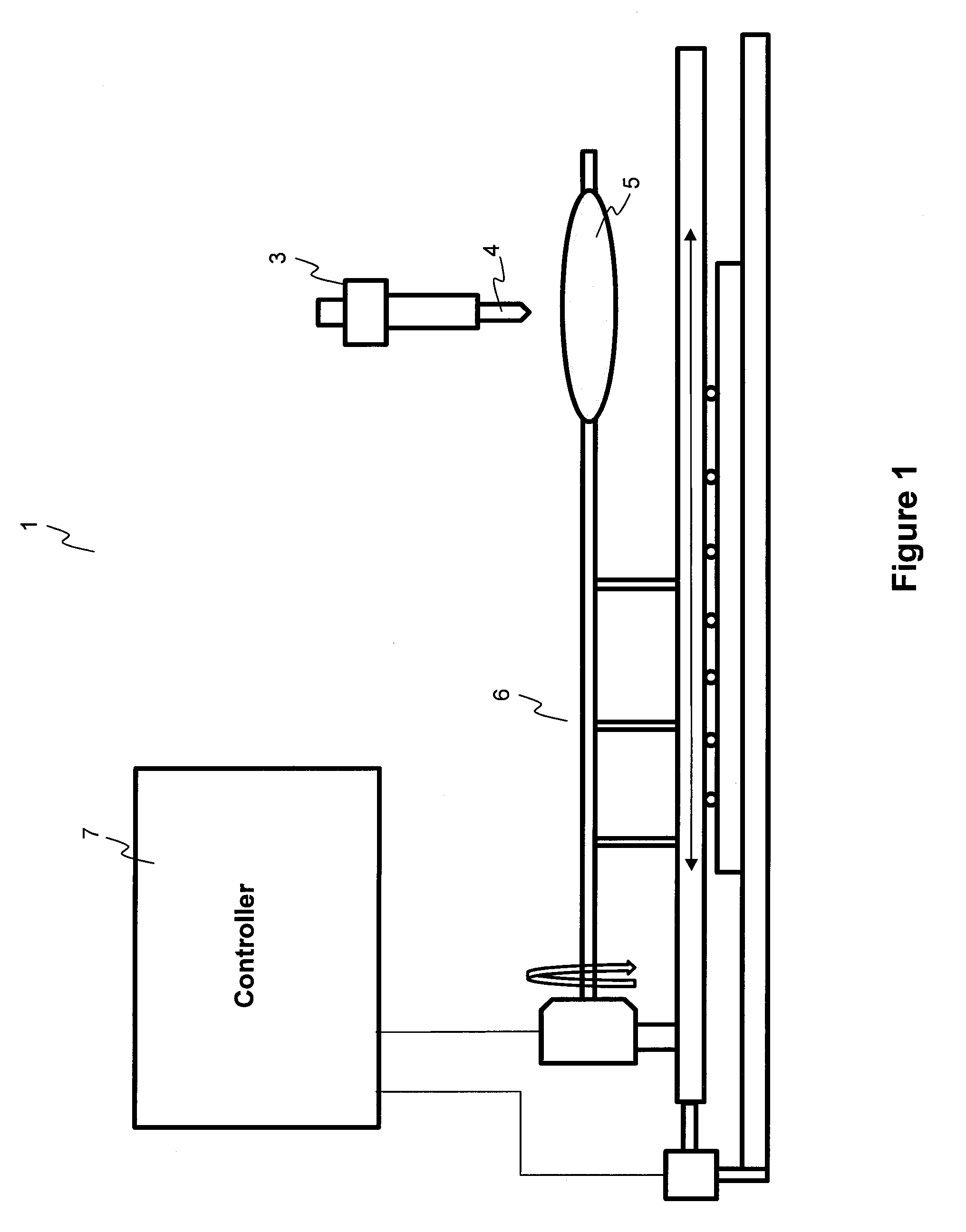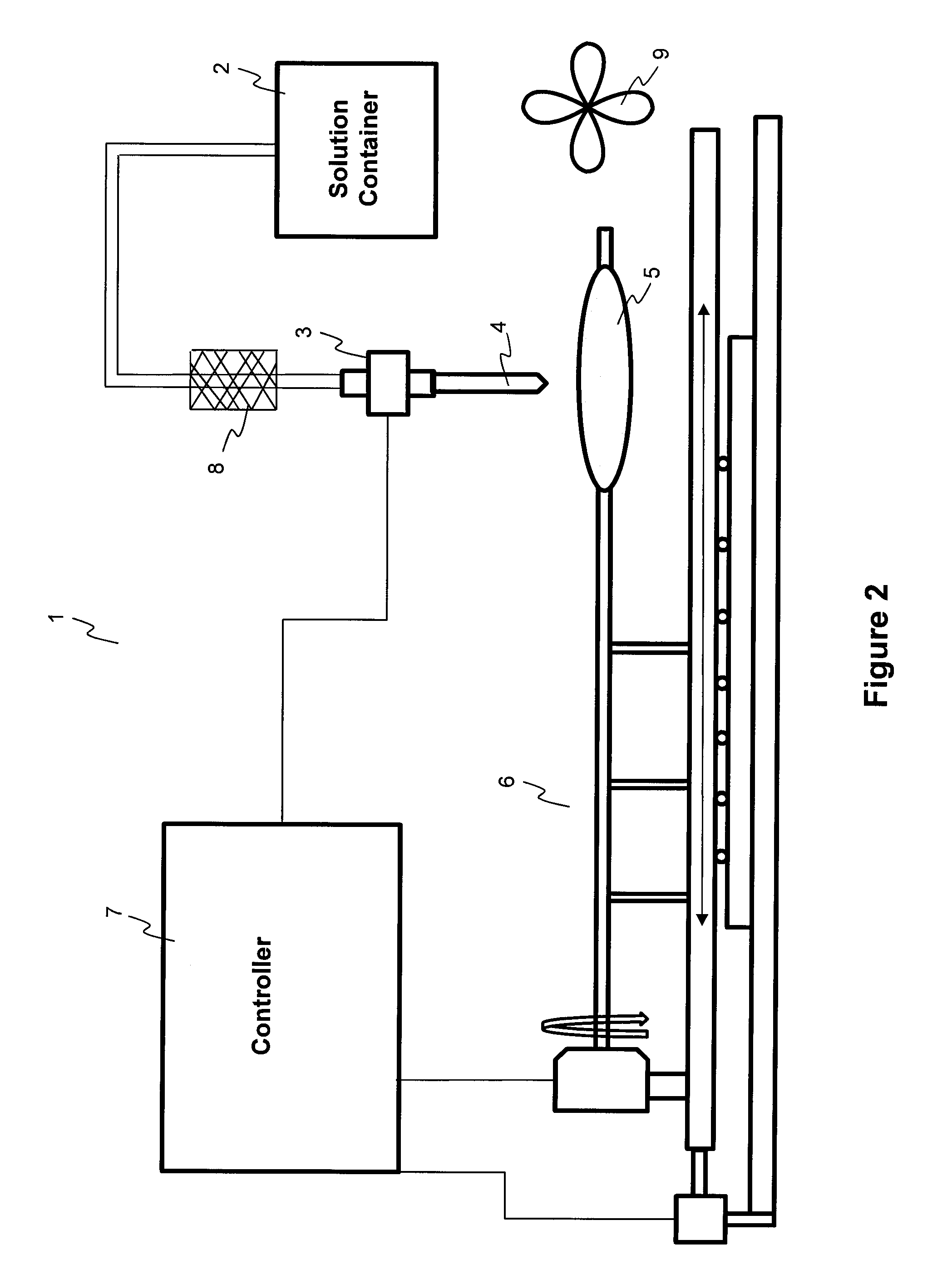Methods and apparatuses for coating balloon catheters
a balloon catheter and coating technology, applied in the field of coating balloon catheters, can solve the problems of inability to control the dose of drugs, the coating layer formed by dipping or spraying is not uniform on the surface, and the drug is not uniformly distributed
- Summary
- Abstract
- Description
- Claims
- Application Information
AI Technical Summary
Benefits of technology
Problems solved by technology
Method used
Image
Examples
example 1
[0085]Preparation of coating solutions: 70 mg of Octanoyl-N-methylglucamide was added into 1.0 ml of solvent mixture (50% acetone and 50% ethanol). Then, 35 mg of paclitaxel was added into the solution. The solution was mixed at room temperature until a homogeneous solution was obtained.
[0086]A PTCA balloon catheter (3.5 mm in diameter and 20 mm in length) was inflated at 2 atm. A pipette (Fisher Scientific, Finnpipette 5-50 μl) was used to pipette 25 μl of solution, and then the solution was transferred onto the inflated 3.5 mm×20 mm balloon catheter. The solution was flowing on the surface of the balloon while the balloon was moving both circumferentially and longitudinally. The time of flowing and evaporation of the solvent and solidification of the coating is about 1 minute after the dispensing of the coating solution on the surface of the balloon catheter. The residual solvent was evaporated and the coating was dried at room temperature for 12 hours. The balloon was folded, rew...
example 2
[0090]Preparation of coating solutions: 35 mg of Octanoyl-N-methylglucamide and 35 mg of Tween 20 were added into 1.0 ml of solvent mixture (50% acetone and 50% ethanol). Then, 35 mg of paclitaxel was added into the solution. The solution was mixed at room temperature until a homogeneous solution was obtained.
[0091]A PTCA balloon catheter (3.5 mm in diameter and 20 mm in length) was inflated at 2 atm. A pipette (Fisher Scientific, Finnpipette 5-50 μl) was used to pipette 23 μl of solution (volume calibrated for dispensing of 660 μg drug), and then the solution was transferred onto the inflated 3.5 mm×20 mm balloon catheter and the solution was flowing on the surface of the balloon while the balloon was moving both circumferentially and longitudinally. The time of flowing and solvent evaporation and solidification of the coating is about 1 minute after the dispensing of the coating solution on the surface of the balloon catheter. The residual solvents were evaporated and the coating ...
example 3
[0093]Preparation of base layer coating solutions: 35 mg of lactobionic acid and 10 mg of diethanolamine were added into 1.0 ml of solvent mixture (25% water, 37.5% acetone and 37.5% ethanol). Then, 35 mg of paclitaxel was added into the solution. The solution was mixed at room temperature or at 50° C. until a homogeneous solution was obtained.
[0094]Preparation of top layer coating solutions: 35 mg of methylparaben was added into 1.0 ml of acetone. The solution was mixed at room temperature until a homogeneous solution was obtained.
[0095]A PTCA balloon catheter (3.5 mm in diameter and 20 mm in length) was inflated at 2 atm. A pipetter (Fisher Scientific, Finnpipette 5 to 50 μl) was used to pipette 25 μl of solution (volume calibrated for dispensing of 770 μg drug), and then the solution was transferred onto the inflated 3.5 mm×20 mm balloon catheter and the solution was flowing on the surface of the balloon while the balloon was moving both circumferentially and longitudinally. The ...
PUM
 Login to View More
Login to View More Abstract
Description
Claims
Application Information
 Login to View More
Login to View More - R&D
- Intellectual Property
- Life Sciences
- Materials
- Tech Scout
- Unparalleled Data Quality
- Higher Quality Content
- 60% Fewer Hallucinations
Browse by: Latest US Patents, China's latest patents, Technical Efficacy Thesaurus, Application Domain, Technology Topic, Popular Technical Reports.
© 2025 PatSnap. All rights reserved.Legal|Privacy policy|Modern Slavery Act Transparency Statement|Sitemap|About US| Contact US: help@patsnap.com



